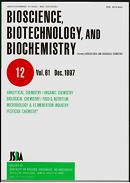Volume 63, Issue 4
Displaying 1-32 of 32 articles from this issue
- |<
- <
- 1
- >
- >|
Analytical Chemistry Regular Paper
-
1999 Volume 63 Issue 4 Pages 743-748
Published: 1999
Released on J-STAGE: March 17, 2005
Download PDF (1337K)
Analytical Chemistry Note
-
1999 Volume 63 Issue 4 Pages 773-775
Published: 1999
Released on J-STAGE: March 17, 2005
Download PDF (800K)
Organic Chemistry Regular Papers
-
1999 Volume 63 Issue 4 Pages 731-735
Published: 1999
Released on J-STAGE: March 17, 2005
Download PDF (862K) -
1999 Volume 63 Issue 4 Pages 736-742
Published: 1999
Released on J-STAGE: March 17, 2005
Download PDF (1468K)
Organic Chemistry Notes
-
1999 Volume 63 Issue 4 Pages 756-759
Published: 1999
Released on J-STAGE: March 17, 2005
Download PDF (1056K) -
1999 Volume 63 Issue 4 Pages 760-761
Published: 1999
Released on J-STAGE: March 17, 2005
Download PDF (878K)
Biochemistry & Molecular Biology Regular Papers
-
1999 Volume 63 Issue 4 Pages 619-626
Published: 1999
Released on J-STAGE: March 17, 2005
Download PDF (1429K) -
1999 Volume 63 Issue 4 Pages 632-637
Published: 1999
Released on J-STAGE: March 17, 2005
Download PDF (6420K) -
1999 Volume 63 Issue 4 Pages 648-654
Published: 1999
Released on J-STAGE: March 17, 2005
Download PDF (1503K) -
1999 Volume 63 Issue 4 Pages 666-671
Published: 1999
Released on J-STAGE: March 17, 2005
Download PDF (1287K) -
1999 Volume 63 Issue 4 Pages 710-718
Published: 1999
Released on J-STAGE: March 17, 2005
Download PDF (2898K) -
1999 Volume 63 Issue 4 Pages 719-725
Published: 1999
Released on J-STAGE: March 17, 2005
Download PDF (2645K) -
1999 Volume 63 Issue 4 Pages 726-730
Published: 1999
Released on J-STAGE: March 17, 2005
Download PDF (1294K)
Biochemistry & Molecular Biology Notes
-
1999 Volume 63 Issue 4 Pages 762-766
Published: 1999
Released on J-STAGE: March 17, 2005
Download PDF (1033K) -
1999 Volume 63 Issue 4 Pages 767-768
Published: 1999
Released on J-STAGE: March 17, 2005
Download PDF (708K) -
1999 Volume 63 Issue 4 Pages 769-772
Published: 1999
Released on J-STAGE: March 17, 2005
Download PDF (1477K) -
1999 Volume 63 Issue 4 Pages 776-778
Published: 1999
Released on J-STAGE: March 17, 2005
Download PDF (1098K)
Biochemistry & Molecular Biology Preliminary Communication
-
1999 Volume 63 Issue 4 Pages 779-783
Published: 1999
Released on J-STAGE: March 17, 2005
Download PDF (2035K)
Food & Nutrition Science Regular Papers
-
1999 Volume 63 Issue 4 Pages 615-618
Published: 1999
Released on J-STAGE: March 17, 2005
Download PDF (882K) -
1999 Volume 63 Issue 4 Pages 638-641
Published: 1999
Released on J-STAGE: March 17, 2005
Download PDF (1291K) -
1999 Volume 63 Issue 4 Pages 642-647
Published: 1999
Released on J-STAGE: March 17, 2005
Download PDF (2598K) -
1999 Volume 63 Issue 4 Pages 655-661
Published: 1999
Released on J-STAGE: March 17, 2005
Download PDF (2056K) -
1999 Volume 63 Issue 4 Pages 662-665
Published: 1999
Released on J-STAGE: March 17, 2005
Download PDF (1399K) -
1999 Volume 63 Issue 4 Pages 680-687
Published: 1999
Released on J-STAGE: March 17, 2005
Download PDF (2744K) -
1999 Volume 63 Issue 4 Pages 698-702
Published: 1999
Released on J-STAGE: March 17, 2005
Download PDF (1189K)
Food & Nutrition Science Notes
-
1999 Volume 63 Issue 4 Pages 749-752
Published: 1999
Released on J-STAGE: March 17, 2005
Download PDF (1122K) -
1999 Volume 63 Issue 4 Pages 753-755
Published: 1999
Released on J-STAGE: March 17, 2005
Download PDF (961K)
Microbiology & Fermentation Technology Regular Papers
-
1999 Volume 63 Issue 4 Pages 627-631
Published: 1999
Released on J-STAGE: March 17, 2005
Download PDF (1009K) -
1999 Volume 63 Issue 4 Pages 672-679
Published: 1999
Released on J-STAGE: March 17, 2005
Download PDF (1537K) -
1999 Volume 63 Issue 4 Pages 688-697
Published: 1999
Released on J-STAGE: March 17, 2005
Download PDF (2091K) -
1999 Volume 63 Issue 4 Pages 703-709
Published: 1999
Released on J-STAGE: March 17, 2005
Download PDF (2646K)
-
2005 Volume 63 Issue 4 Pages 784
Published: 2005
Released on J-STAGE: March 31, 2005
Download PDF (22K)
- |<
- <
- 1
- >
- >|
